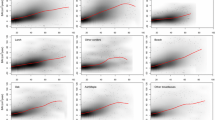Abstract
This study predicts the regeneration establishment on 3-year-old Norway spruce (Picea abies (L.) Karst.) plantations in southern Finland using regeneration survey data. Regeneration establishment was described by seven response variables: number of planted spruces, natural Scots pines (Pinus sylvestris L.), natural spruces, natural seed-origin birches (Betula pubescens Ehrh. and B. pendula Roth.) and other broadleaves (i.e. sprout-origin birches and other broadleaves than birch), as well as height of crop-tree spruce and dominant height of broadleaves. Due to the multivariate (several responses for each plot) and multilevel (plot, stand, municipality, forest centre) structure, regeneration establishment was modelled by fitting a multivariate multilevel model with explanatory variables such as temperature sum, site fertility, soil quality and method of site preparation. In the model, the numbers of tree seedlings were modelled using over-dispersed Poisson distributed equations, and the tree heights were modelled using normally distributed linear equations. The estimated fixed and random parameters of the equations were logical, and there was no serious bias in predicting the regeneration establishment in the independent test data set. This modelling approach can be used to predict the regeneration establishment stochastically by taking into account the large unexplained variation in regeneration models.
Similar content being viewed by others

References
Cajander A.K. (1926) The theory of forest types. Acta For. Fenn. 29(3):108
Ferguson D.E. 1997. Regeneration models for FVS variants. In: Teck R., Moeur M. and Adams J. (eds), Proceedings: Forest Vegetation Simulator Conference, Fort Collins, CO, February 3–7, 1997. USDA, Forest Service, General Technical Report INT-GTR-373, pp. 43-49
Ferguson D.E. and Carlson C.E. 1993. Predicting regeneration establishment with the Prognosis model. USDA, Forest Service, Research Paper INT-467, 54 pp
Ferguson D.E., Stage A.R., Boyd R.J. 1986. Predicting Regeneration in the Grand Fir-cedar-hemlock Ecosystem of the Northern Rocky Mountains. For. Sci. Monograph 26, 41 pp
Finnish Statistical Yearbook of Forestry. 2003. The Finnish Forest Research Institute. SVT, Agriculture, Forestry and Fishery 45, 385 pp
Goldstein H. 1996. Multilevel Statistical Models. Kendall’s Library of Statistics 3, 2nd ed., p. 178
Hasenauer H., Kindermann G. (2002) Methods for assessing regeneration establishment and height growth in uneven-aged mixed species stands. Forestry 75: 385-394
Hynynen J., Ojansuu R., Hökkä H., Siipilehto J., Salminen H. and Haapala P. 2002. Models for predicting stand development in MELA System. Finnish Forest Research Institute, Research papers 835, 116 pp
Kozlowski T.T. (2002) Physiological ecology of natural regeneration of harvested and disturbed forest stands: implications for forest management. For. Ecol. Manage. 158: 195–221
Laine J. and Vasander H. 1993. Suotyypit. 3rd ed. Kirjayhtymä, Helsinki, 80 pp
Luonnonläheinen metsänhoito. Metsänhoitosuositukset. 1994. Metsäkeskus Tapion julkaisuja 6/1994, 72 pp
McCullagh P. and Nelder J.A. 1989. Generalized Linear Models, 2nd ed. Chapman and Hall, University Press, Cambridge, 511 pp
Monserud R.A., Sterba H. and Hasenauer H. 1997. The single-tree stand growth simulator PROGNAUS. In: Teck R., Moeur M. and Adams J. (eds), Proceedings: Forest Vegetation Simulator Conference, Fort Collins, CO, February 3–7, 1997. USDA, Forest Service, General Technical Report INT-GTR-373, pp. 50–56
Ojansuu R., Henttonen H. (1983) Estimation of local values of monthly mean temperature, effective temperature sum and precipitation sum for the measurements made by the Finnish Meteorological Office. Silva Fenn. 17:143–160
Rasbash J., Browne W., Goldstein H., Yang M., Plewis I., Healy M., Woodhouse G., Draper D., Langford I. and Lewis T. 2000. A User’s Guide to MLwiN Version 2.1.a. University of London, UK, 278 pp
Ripley B.D. 1981. Spatial Statistics. Wiley, New York, 252 pp
Ripley B.D. 1987. Stochastic Simulation. Wiley, New York, 237 pp
Saarenmaa L. (1990) Choice of reforestation method based on an expert system in Finnish Lapland. Folia For. 762:49
Saksa T. 1992. Development of Scots pine plantations in prepared reforestation areas. Dissertation. Finnish Forest Research Institute, Research papers 418, 48 pp
Saksa T., Särkkä-Pakkala K., Smolander H. (2002) Työkalu metsänuudistamisen laatutyöhön. Metsätieteen aikakauskirja 1: 29–34
Schweiger J., Sterba H. (1997) A model describing natural regeneration recruitment of Norway spruce (Picea abies (L.) Karst.) in Austria. For. Ecol. Manage. 97: 107–118
Searle S.R., Casella G. and McCulloch C.E. 1992. Variance Components. Wiley, New York, 501 pp
Snijders T. and Bosker R. 1999. Multilevel Analysis. An Introduction to Basic and Advanced Multilevel Modeling. SAGE Publications Inc., London, 266 pp
Wilson G.F. and Maguire D.A. 1996. Simulation of early regeneration processes in mixed-species forests of Maine, USA: Germination, survival, and height growth. In: Skovsgaard J.P. and Johannsen V.K. (eds), Modelling Regeneration Success and Early Growth of Forest Stands. Proceedings from the IUFRO Conference, held in Copenhagen, 10–13 June 1996. Danish Forest and Landscape Research Institute, Hørsholm, pp. 530–539
Author information
Authors and Affiliations
Corresponding author
Rights and permissions
About this article
Cite this article
Miina, J., Saksa, T. Predicting regeneration establishment in Norway spruce plantations using a multivariate multilevel model. New Forests 32, 265–283 (2006). https://doi.org/10.1007/s11056-006-9002-y
Received:
Accepted:
Published:
Issue Date:
DOI: https://doi.org/10.1007/s11056-006-9002-y



